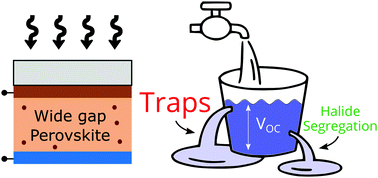Revealing the origin of voltage loss in mixed-halide perovskite solar cells†
Abstract
The tunable bandgap of metal-halide perovskites has opened up the possibility of tandem solar cells with over 30% efficiency. Iodide–bromide (I–Br) mixed-halide perovskites are crucial to achieve the optimum bandgap for such tandems. However, when the Br content is increased to widen the bandgap, cells fail to deliver the expected increase in open-circuit voltage (VOC). This loss in VOC has been attributed to photo-induced halide segregation. Here, we combine Fourier transform photocurrent spectroscopy (FTPS) with detailed balance calculations to quantify the voltage loss resulting from halide segregation, thus providing a means to quantify the impact of the low bandgap iodide-rich phases on performance. Our results indicate that, contrary to popular belief, halide segregation is not the dominant VOC loss mechanism in Br-rich wide bandgap cells. Rather, the loss is dominated by the relatively low initial radiative efficiency of the cells, which arises from both imperfections within the absorber layer, and at the perovskite/charge extraction layer heterojunctions. We thus identify that focussing on maximising the initial radiative efficiency of the mixed-halide films and devices is more important than attempting to suppress halide segregation. Our results suggest that a VOC of up to 1.33 V is within reach for a 1.77 eV bandgap perovskite, even if halide segregation cannot be suppressed.



 Please wait while we load your content...
Please wait while we load your content...